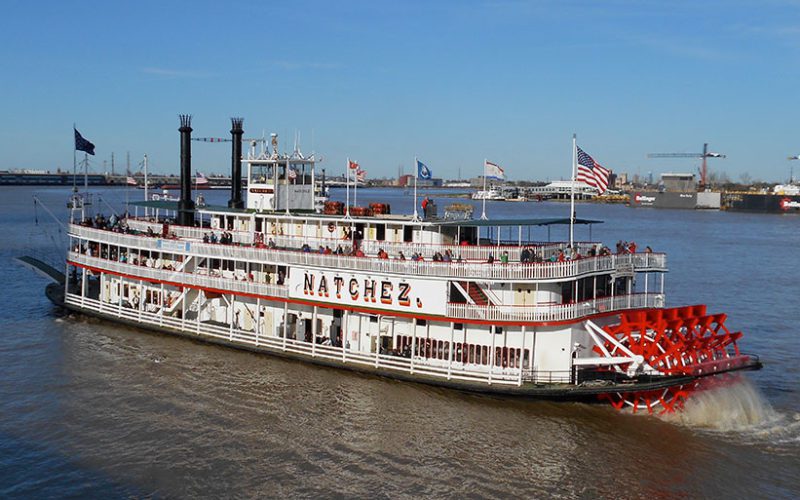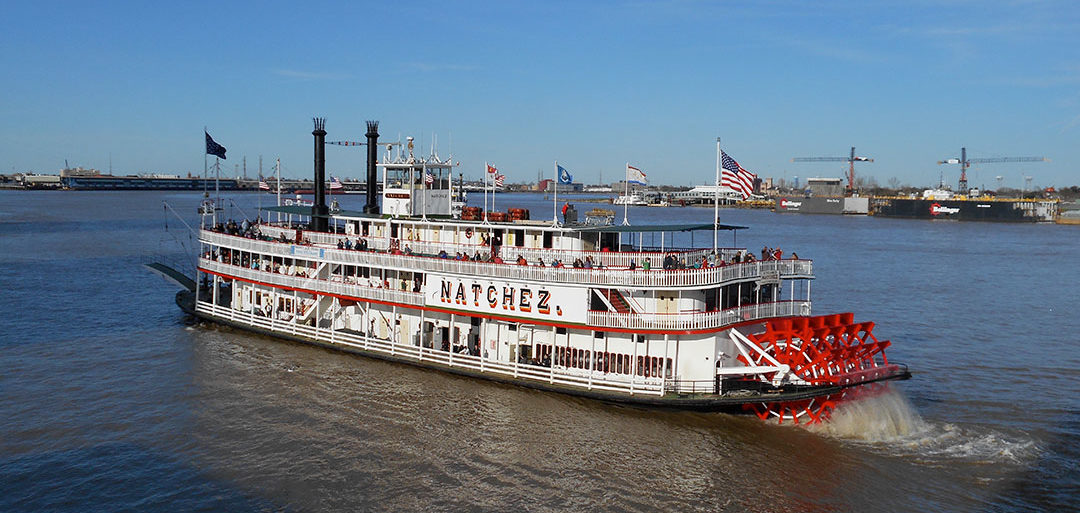
Steam is at the heart of the sternwheeler Natchez of New Orleans, launched in 1975 and named after the historic city also located along the Mississippi River. Steam powers the 265-by-46-foot passenger vessel up and down the mighty waterway.
I decided to take a ride on Natchez as an ordinary passenger to see for myself what this modern U.S. Coast Guard-inspected vessel featuring a historic steam propulsion plant was all about. I wanted to experience the entire operation from start to finish.
The ticket sellers at the New Orleans Steamboat Co. issued discounts to all members of the armed services, just like so many other companies do, but I was pleasantly surprised when they showed the same courtesy to merchant mariners. I purchased the buffet lunch along with a regular ticket because I was interested to see what the food service was all about too. I had once been the commissary officer of a passenger vessel and the master of dinner boats among my many maritime jobs. All of the food was excellent, but the battered and fried fish was the best I’ve ever tasted. It was outstanding and rivaled the output of many New Orleans restaurants.
The narration was also done well. I’ve done that job too. It was just the way it should be: informative and pleasant without constant talking throughout the whole cruise, which can be annoying at best. Due to the weight of the vessel — 1,384 gross tons — the ride turned out to be a smooth one. The amenities were superb, but it was now time to check out the engine room.
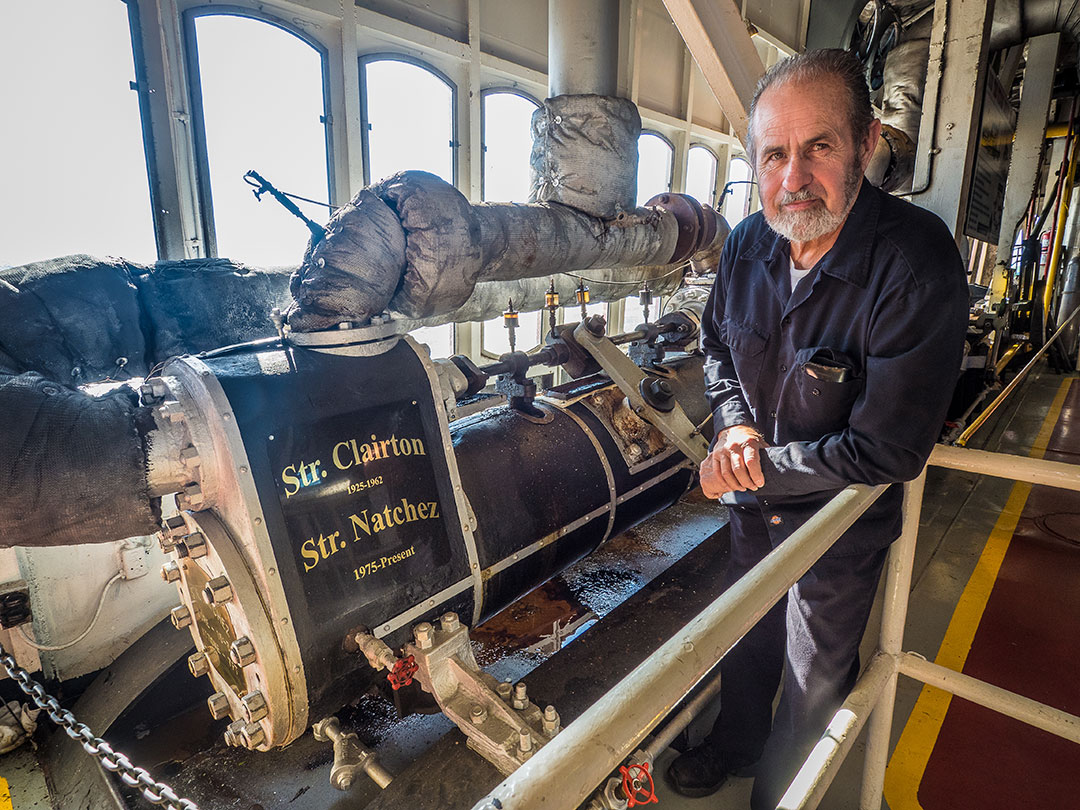
Walking aft along the port-side passageway, I entered the engine room and met chief engineer Scott Vieages. The word had gotten out that I was a maritime journalist, so Vieages gave me the VIP tour. What immediately caught my eye were the large horizontal piston cylinders on either side of the engine room. Steel pistons were moving in and out of them, with a bit of steam and condensed water spurting out of the seals with every cycle. The two large piston rods were linked to the paddlewheel, turning linear propulsion into circular thrust.
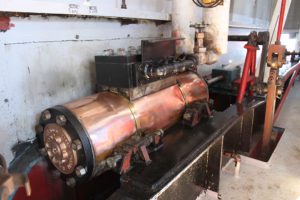
I was also fascinated by the automatic piston rod oilers. It was almost hypnotic watching a small tab on the end of each shaft carefully tip the oilers to deposit just a drop or two onto the cylinder shafts with each piston stroke. The whole engine room looked like a Rube Goldberg setup that worked flawlessly.
Vieages explained how the boilers burned diesel fuel that heated the water into steam, propelling the two large pistons, which in turn rotated the paddlewheel. I’ve been a qualified engineer on a couple of passenger vessels, but I’ve never seen anything quite like this setup. It was well worth the price of admission just to see the propulsion system in action. The operation piqued my curiosity as to how someone would be qualified and licensed to run such an engineering apparatus.
Yes, there is a Coast Guard engineering license for shipboard steam power plants, and Vieages’ story of obtaining his steam engineering license is nothing less than an incredible journey. Both Vieages and his son, chief engineer Scott Vieages Jr., had to first become documented oilers and then licensed designated duty engineers (DDEs) working under a chief engineer.
Vieages said that when he took the chief’s test, it was almost the same as the DDE test. The DDE test had 50 questions and the chief’s test had 70 questions. The additional 20 questions were mostly based on electrical systems. Fortunately, Vieages had helped build Natchez at Bergeron Shipyard, including the installation of its electrical equipment. Prior to that shipyard work, the U.S. Navy veteran had worked at a marine supply store. All of that practical experience helped him pass the chief engineer test.
To become a chief engineer on inland steamboats, you must first get certified as a qualified member of the engine department (QMED). After becoming a documented QMED, you can get licensed as a limited DDE, then go for your chief’s license for inland paddlewheel boats. The process includes a lengthy list of steps and requirements involving sea time, engine room experience, and completion of a Coast Guard-approved engineering course for the type of propulsion (steam, motor or gas turbine). There are also other certifications required that most mariners have already, such as first aid, medical exam, drug testing and shipboard firefighting.
I spoke with Lt. Eric Hatfield of the Coast Guard’s National Maritime Center about the requirements, which he said are just about right but include exceptions — the most common one being that you can skip all of the steps if you major in engineering and graduate from a full-time maritime academy. There are also Coast Guard-approved courses that may be substituted here and there to either eliminate or reduce some of the steps.
Hatfield said most prospective engineers apply for unlimited horsepower licenses. We also chatted about how the rules have changed over the years. If you want a QMED, DDE or chief engineer license, I suggest that you do some research before you start, because some of the requirements may not apply to your particular case. As for Vieages, he went through all of the processes for each of the licenses.
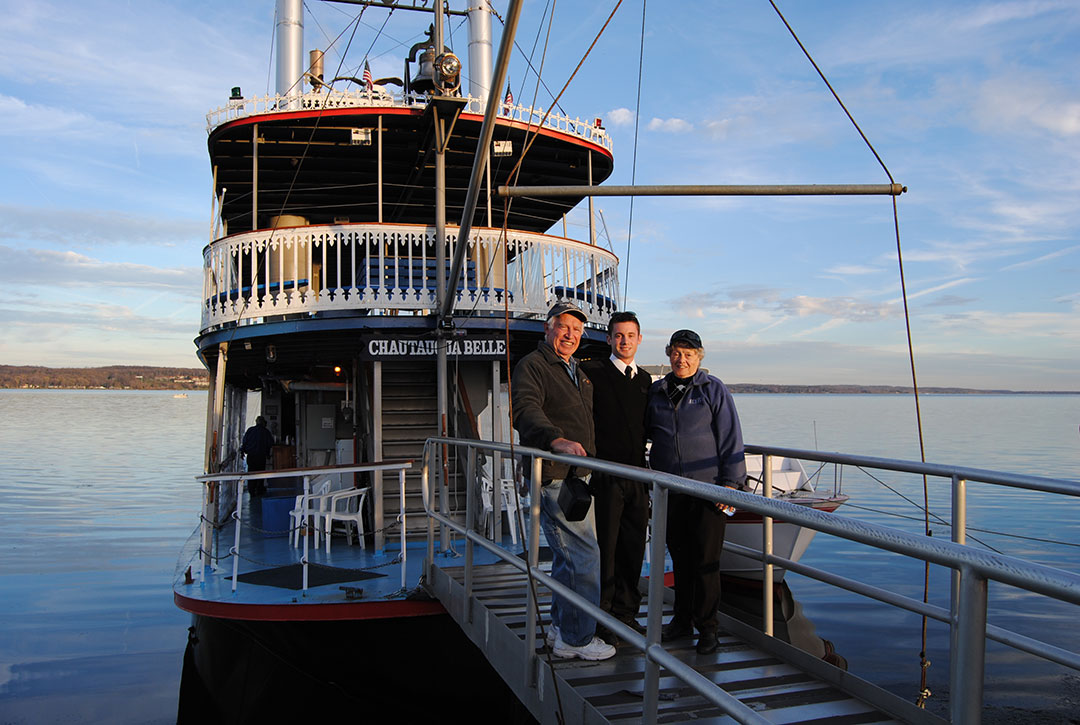
There are other notable mariners of steam paddlewheel fame, including Capt. Mathew Stage, who owns Chautauqua Belle on New York’s Chautauqua Lake. That steam-powered vessel is 98 feet long and weighs 60 gross tons. Stage started working on the boat at just 18 years old. He is now serving on a large cruise ship while holding an unlimited master’s license. He’s a graduate of SUNY Maritime College.
I didn’t get a chance to interview Stage, but I did get the opportunity to have an informative conversation with the president of the Lake George Steamboat Co., William Dow, who owns and operates the steam-powered paddlewheeler Minne-Ha-Ha in Upstate New York. The vessel is 137 feet long and weighs just under 100 gross tons.
Dow, who is also a co-owner of Natchez, described some of the similarities and differences between his two vessels. Both are steam-powered passenger vessels with paddlewheels, but each is subject to a different regulatory authority. The larger Natchez operates on navigable waterways. Therefore, the vessel is inspected and certified by the U.S. Coast Guard, and its crew is licensed by the service. The smaller Minne-Ha-Ha, which operates on the enclosed waters of Lake George, is regulated by the Marine Services Bureau of New York State Parks, just like Stage’s New York vessel.
Natchez is inspected every five years (operating on rivers) by the Coast Guard, and its crew must renew their licenses every five years. Minne-Ha-Ha is inspected every year by state personnel out of Albany, and its crew must renew their licenses annually. Both the captain and engineer on Minne-Ha-Ha took written tests, just like the Coast Guard demands of its professional mariners. However, both also had to take initial practical onboard examinations on the 32-mile-long Lake George.
Few mariners know that the Coast Guard reserves the right to test any Coast Guard licensed, certified or documented person by observing practical demonstrations of their abilities. I actually knew a licensed master who had to go through such an onboard test by the Coast Guard. I sailed with him once and subsequently learned about the practical testing after the cruise was over. I won’t tell you what he was doing on his four-hour bridge watch when I walked into the pilothouse to relieve him, because it’s so fantastic that you probably wouldn’t believe me. Let’s just say that I had to get an immediate position fix and draw a new course line in great haste. The point is that he was the exception to the rule.
The public should feel safe riding on any of these steam-powered vessels. They all have the required safety equipment, and the crews are well-trained and competent. Their jobs are not easy ones either. I observed all of Natchez’s crew perform very well. The dock receptionist was a retired ship captain. It was smart having such an experienced person at that job, and he kept everyone safe as they boarded and disembarked from the ship. That’s where the majority of passenger accidents occur. The master also did an excellent job of ship handling during my cruise, including performing a smooth docking procedure. He made it look easy. It’s not.
The handling characteristics of paddlewheelers can be challenging at times. I was the licensed master of a paddlewheeler for six years on the Napa River in California. The Napa had its fair share of treacherous currents, snags, sandbars, vessel traffic and even low-hanging tree branches. The 76-foot Napa Valley Riverboat was just barely under 100 gross tons so that it could be inspected under Subchapter T. It was a handful! It had a flat bottom with a shallow draft and a huge superstructure with which the wind had its way. The pilothouse was positioned right up forward, practically sitting on the bow. I spent half the time looking aft to get a reference on how and where the boat was actually heading. It was slow to answer its helm and slow to check its swing. That vessel even had flanking rudders positioned forward of the paddlewheel as well as the standard aft rudders. They did little to help. I’ve handled much larger vessels in closer quarters easier than that triple-deck paddlewheeler.
The owners of the boat were hit by a drunken driver one night. She was driving on the wrong side of the freeway, and she hit their vehicle head-on. That ended the company and that particular port captain job. Stay alive — don’t drink and drive!
I felt alive again when I took my ride on Natchez on the Mississippi River. I think that you should try it too. These vessels are really floating pieces of history. Sure, I’ve toured many steam-powered vessels, but they were on static display in maritime museums. They were fascinating, but they were also cold, still and silent. These operational vessels are alive and belching steam as their paddlewheels turn and slap the water up and down our lakes and rivers. Every mariner and history buff should try it at least once. It would be a real shame if you missed out on such an adventurous ride. •
Capt. Marc Deglinnocenti has sea time on various types of vessels dating back to 1974. Those vessels included conventional and tractor tugs, sailboats, training ships, warships, cargo barges, containerships, passenger vessels, and research vessels to name a few. He was in the U.S. Merchant Marine for 33 years, 25 of which as a master mariner. He was also a qualified engineer and held many individual certifications and positions on ships such as able bodied seaman, engineering officer, deck officer, commissary officer, and he even was a California credentialed maritime teacher.

